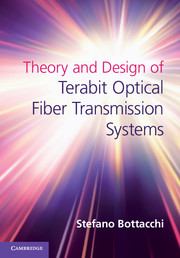Book contents
- Frontmatter
- Dedication
- Contents
- Preface
- Acknowledgments
- Part I Signals, spectra and optical modulations
- Part II Principles of light polarization and optical amplification
- 4 Principles of non-linear optics and light polarization
- 5 Principles of light amplification
- 6 Spectral gain modeling of optical amplifiers
- 7 Noise theory of optical amplifiers
- Part III Interferometric optical modulators
- Part IV
- Appendix A Electromagnetic energy and power flow
- Appendix B Optical power and photon flux
- Index
- References
4 - Principles of non-linear optics and light polarization
Increasing the dimensionality of the light field
from Part II - Principles of light polarization and optical amplification
Published online by Cambridge University Press: 05 September 2014
- Frontmatter
- Dedication
- Contents
- Preface
- Acknowledgments
- Part I Signals, spectra and optical modulations
- Part II Principles of light polarization and optical amplification
- 4 Principles of non-linear optics and light polarization
- 5 Principles of light amplification
- 6 Spectral gain modeling of optical amplifiers
- 7 Noise theory of optical amplifiers
- Part III Interferometric optical modulators
- Part IV
- Appendix A Electromagnetic energy and power flow
- Appendix B Optical power and photon flux
- Index
- References
Summary
Introduction
This chapter begins the second part of the book, dealing with fundamental principles of non-linear optics and light polarization. These notions are essential to understanding the interactions between the electric field and matter, and in particular with dielectric materials in glass-based optical fibers and more generally in every dielectric waveguide. Nowadays, optical communication requires a deep understanding of several engineering disciplines to reach optimum transmission performance, and basic concepts of non-linear optics as well as light polarization must be mastered by every engineer working in this fascinating field.
Section 4.2 briefly reviews the Maxwell equations and the constitutive relationships, focused on dielectric and diamagnetic materials, widely used in optical communication. Section 4.3 introduces the dielectric polarization field from a macroscopic point of view, introducing the series expansion model and related higher-order polarization components. The usual linear polarization is only a first-order approximation of the interaction between the applied electric field and the material response. The linear dielectric susceptibility and dielectric permittivity are then generalized to account for higher-order interactions, introducing the formalism of tensor quantities, with interesting dual representations in time and frequency domains. Section 4.4 translates the concepts introduced in the preceding section to common macroscopic properties of the dielectric medium, justifying several assumptions quite often made as postulates.
Information
- Type
- Chapter
- Information
- Theory and Design of Terabit Optical Fiber Transmission Systems , pp. 213 - 298Publisher: Cambridge University PressPrint publication year: 2014
